Does the word Bitcoin ring a bell? And Blockchain? You probably first heard of Bitcoin, a cryptocurrency, but Blockchain is the Bitcoin underlying technology.
Blockchain is a distributed ledger technology that records, and tracks data based on a decentralised and transparent system. It is a chain of blocks that register and transfer information in a safe and auditable way, open to anyone. A system built on Blockchain does not have an institution or organisation as an intermediary such as a bank; the transactions occur directly peer-to-peer.

Bitcoin is a form of electronic cash, the most popular in the market, so using a bank transaction example will make it easier to understand how it works. Traditionally, in a financial transaction, if someone wants to send money to another person, there will be a bank as an intermediary. The bank is the organisation responsible for making the transfer and guaranteeing it to both parts the sender and the recipient. Generally, as a bank service, it will be made based on the bank rules and fees, and the sender and recipient have neither control nor access to this information.
Otherwise, Blockchain allows every peer to access the information as a shared spreadsheet interacting, updating and validating a transaction. The data is recorded in blocks; each new information adds a new block in the chain in a chronological way where all further information is registered and never erased.
The Blockchain database is shared by all actors in the system, monitored by everybody and no one is the owner or controls it alone; each peer has a copy of the chain of blocks and a transaction will be completed only when everyone agrees on it. There is no need to trust other people because we will be relying on the system.

Blockchain has been considered a disruptive technology compared to the Internet, promising innovation in the financial and commercial area comparable to the impact that the Web had on communication. It stands to revolutionise the way we interact with each other based on three main concepts:
- Track and data store – the decentralised and distributed system across an extensive network of computers becomes a safe way to track data changes over time.
- Trust – it is the key concept. The system allows us to interact directly with our data in real-time and the network, all the computers verifies the changes in the transactions which creates trust in the data.
- Peer-to-peer transactions – in this system there is no more intermediaries. Instead of sharing our data with an intermediary such as a bank or a lawyer, we will share it directly with peers. It is a new way to access, verify and transact with each other.
Smart contracts are computers protocols based on Blockchain which aims to facilitate and verify deals going beyond buying and selling currency transactions. Its benefits include extensive instructions on agreements between two or more parties to complete or not complete a transaction, removing the need to trust the parties. In these contracts the “code is law”, the established agreement will be done no matter what.
The idea of transparency and peer-to-peer network control is easier to understand in a financial example, but it can be used for other transactions in other areas (health, property, vote) and with another currency trading. Anyone will be able to create tokens representing certificates, coupons, access rights, payments, or smart contracts that regulate the relationships between different actors in the legal and economic system.
The Blockchain is a promising technology for recording and tracking anything of value in a transparent, democratic and safe system. A completely public Blockchain allows everyone to view and access the data. A private system can select a group of users from an institution or organisation to view and/or edit data. And in a hybrid system, some peers can see all the data while others can see only selections; or all can see all the data, but only some can add new data.
Let’s take a look at a final example. Registering land and property gives people proof of ownership, helps protect owner land from fraud and makes it easier to change, sell or give property or land away in the future. Usually, individuals can register a property themselves or get a solicitor or conveyancer to do it.
Now, imagine the government decide to implement Blockchain to record land and property data and transactions. It could be a hybrid system that combines two networks. One public network, where any citizen can see the boundaries of property information. The other network would contain the private information that is only accessible by a closed group like government administrators.
In the case of buying or selling a property using smart contracts (simpler, faster and cheaper) there will be no need to get an intermediary or a solicitor or conveyancer to register your property. Once the seller gets all the payments, or what is pre-established on a smart contract, the property registration could be transferred to the new owner. Technically, a new block with further information would be recorded on the chain of blocks keeping all the previous data on the land or property.
As you can see, it is just the beginning. There is a range of possibilities to explore, experiment and build system using Blockchain. The benefit of implementing Blockchain methodology into the Public Administrations, is to enable the co-production on public services such as health, education, social welfare, and mobility.


